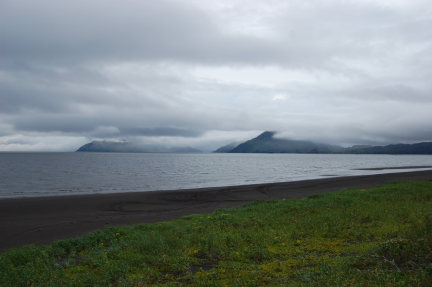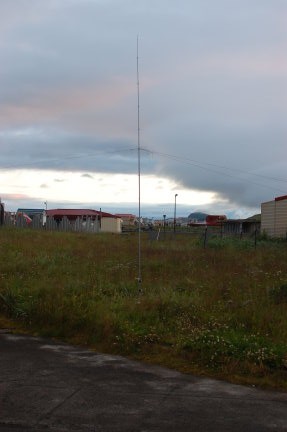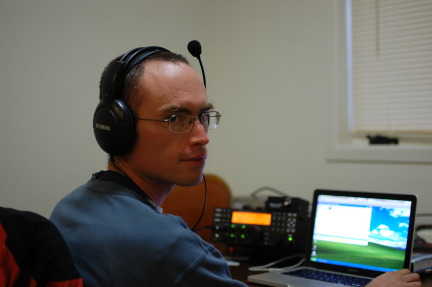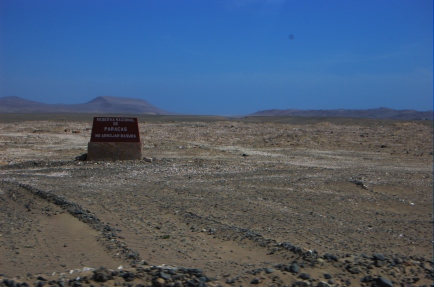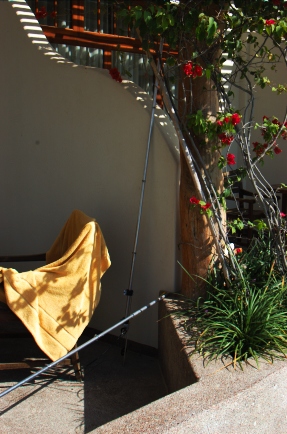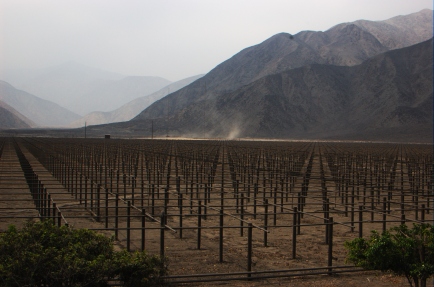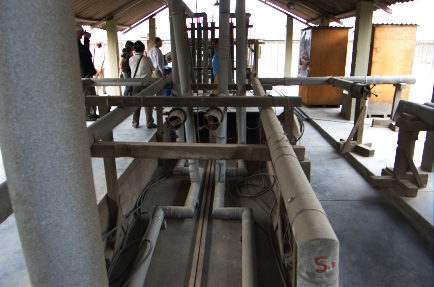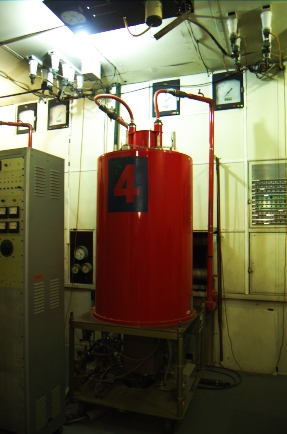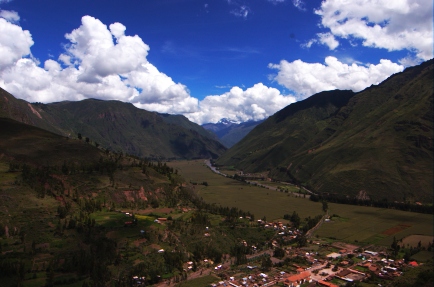Posts Tagged ‘DX operating’
 New Radio Thoughts
New Radio Thoughts
As I mentioned in a previous post about my trip to the Aleutians, I am the owner of a new radio. The reasons for the purchase were manifold, but driven by a fundamental shift in the way I view my operating (and living) philosophy. I had long (at least 10 years) been collecting gear for a two- (or three-) tower contest station. In this philosophy, the emphasis was on collecting antennas and towers as they became available on attractive terms. It also meant keeping the inexpensive but well-performing pair of TS-930S HF transceivers for my SO2R setup and the FT-840 for my portable operations. You can imagine from those past few sentences of description alone that this consumed a non-trivial amount of space and time.
Sarah began subtly hinting that “wouldn’t it be nice if we could clean up that pile of tower on the patio so we could have people over?” My parents have been slowly migrating my junkbox from their place to ours. It became increasingly clear to me that as long as we lived in this area it would be unlikely that I would put up the towers. I started contemplating how to remedy this situation. I identified a large collection of gear (including the Rohn 45 on the patio) that 1) could be replaced by a new radio, 2) I was not using, or 3) for which I simply did not have a plan. So, I set out with the following theme to find a new rig:
Excellence in portable operation and competence at home.
I considered four radios: Ten-Tec Eagle, Kenwood TS-590S, Elecraft K2/100, Elecraft K3/100.
I was strongly considering the K2/100 initially. Its size and price seemed attractive. However, when I did the math on what configuration I wanted, it basically ended up a draw with the Kenwood and the Ten-Tec with only a small bump more to the K3/100. Plus, I’ve built enough kits to know that many of life’s most rewarding tasks tend to look better in the past than they do in the future. Personal preference, of course!
The Kenwood TS-590S is acclaimed by a number of contesters as “the poor man’s K3.” It has very similar features and performance numbers at a very attractive price. I have always enjoyed Kenwoods as well. But, the one thing that ultimately killed the TS-590S and the Ten-Tec Eagle was their lack of BCD band-data outputs. The K3 also offered the 2-meter option, IF output (for panadapters), and very easy transverter interfacing. It was really a no-brainer for me at that point since I had sold off enough gear to cover the cost entirely.
I bought the K3 kit and assembled it. Anomalies notwithstanding, it amuses me greatly when people announce to the Elecraft e-mail list that “K3 #7777 is on the air”…it’s hard to keep from responding, “Congratulations on assembling your first LEGO kit.” Unlike the K2, these “modular-kit” radios are very easy to assemble if you have a few hand tools and can follow basic directions.
My friend Oli, DJ9AO, informally asked me to compare the K3 to the TS-930S. I’ve tested (subjectively) the K3 in a couple of demanding environments and I’m pleased to say that the K3 performed well, even with essentially “factory default” settings.
The K3 wins hands-down the strong-signal handling contest, even with the Inrad roofing filter in the TS-930S. 40 meters in ARRL Sweepstakes CW is a good test for this. The FT-840 used to have severe mixing products (“beeps and bloops”). These are not common with the TS-930S, but severe AGC pumping from nearby signals often covered up weaker signals. Neither of these are problems with the K3. In fact, the K3 is so good that you can tell just exactly who has key clicks because it’s possible to find two signals of otherwise identical strength on the S-meter and one will be inaudible within a few hundred Hz and the other will continue to bleed through and pump the AGC. Well-done, Elecraft.
One thing that surprised me about the K3 was its apparently poor performance on the pileups from NA-039. With the BW cranked down to 400 Hz, the filters rang like a bell in a pileup. I have the 400-Hz 8-pole and 2.7-kHz 5-pole filters. Widening the DSP bandwidth out to 700 Hz or so (which switches to the 2.7-kHz roofing filter) alleviated the problem with occasional AGC pumping from louder signals in the pileup. In a post to the PVRC e-mail list recently, Frank, W3LPL, also confirmed that he prefers the 1-kHz 8-pole filter for CW operation. Because I had the opportunity, I recently sprung for the special-order 700-Hz roofing filter. It should arrive in March 2013. I suspect there is considerable tailoring that could be done to the AGC system but I’m not there yet. Once I realized that the bandwidth of 700 Hz was a sweet spot, the radio worked great in the pileups. I have a feeling that I’ll also end up with the 1-kHz filter eventually. But, I rarely open up beyond 700 Hz on CW so it will be interesting to see what is best.
A few other bright spots:
- CW-to-Digital: This is just plain cool. Send with the built-in keyer and the radio modulates PSK31 or RTTY for you. Decode it right on the screen.
- Multifunction knobs: The entire industrial design of the K3 is really unmatched in my opinion. It has just the right number of knobs and menus.
- Options: They are plentiful and easy to install. Keeps the initial cost low(er).
I’m extremely delighted with the K3 so far and my shack is getting more compact. It’s also nice to have a radio with a built-in keyer for once…
 The Birthplace of the Wind
The Birthplace of the Wind
I recently had the good fortune (Sarah and some Alaskan friends might question the use of the adjective “good”) to spend about 10 days on the Aleutian island of Adak for work. In the midst of preparing for the trip, I learned that my fellow travelers Kevin, KJ4OAP, and Nathaniel, W2NAF, were planning to bring ham gear. Of course, I was as well, so we ended up with quite the merry bunch of hams on Adak. I don’t collect IOTAs, but I know it’s popular. So, I checked out Adak Island in the IOTA directory—NA-039, Andreanof Group. Fewer than 20% had claimed it, so it’s not super-rare, but not super-common, either. I was assured by at least one friend that we would be very popular, especially in Europe.
One of the first things you notice about Adak when you get off the plane is the wind. In fact, the locals call Adak “the Birthplace of the Wind.” It’s actually quite poetic considering that the winds are so strong that you don’t leave furniture outside and that the houses shudder with typical gusts. I experienced 75-mph gusts and 60-mph sustained winds during my short visit alone.
Adak is probably best known as the forward base from which the U.S. conducted its counteroffensive against the Japanese invasion of Attu and Siska during World War II. It also played an important role during the Cold War and although the military left some 10 years ago, it retains much of the infrastructure including heavy machinery, a port, and a large airport. The population shrank rapidly from a peak of just over 6000 in the 1990s to around 150 today. Just before the military (principally Navy) pulled out, they were in the process of building new base housing. The housing was completed nevertheless and so there are literally dozens if not a hundred homes that have never been occupied! Some of the others have been converted into a small hotel (this is where we stayed).
The economy is heavily dependent on fishing and fish canning right now. However, the locals are excited about the possibility of becoming a logistics hub for oil and gas work in the Bering Sea. In fact, the aircraft I came out on (An Alaska Airlines 737-400) had an unprecedented 60+ passengers on it because executives from an oil company were coming to check the place out.
Alaska Airlines operates “regular” flights twice per week.
Due to a fiction of time zones, Adak is only one hour behind Anchorage, despite being some 27 degrees west. So, sunrise and sunset are both very late in local time. It is also very far south, about the same latitude as Vancouver. Although I arrived at 6:30 pm, it was still light out for almost another four hours. So, I quickly put up the vertical on 20 meters just before sunset.
While we were putting up the vertical, Nathaniel met Jeff, KL2HD, who happened to have flown in on the same flight as us and who also happened to have his office and station across the street from my apartment. Neat. He works for U.S. Fish and Wildlife Service and they have field sites throughout the Aleutians. They use HF to communicate with their camps. So, he just plugs into a well-installed folded dipole to do his hamming. Have you ever seen a folded dipole installed between two (yes, two) Rohn 45 towers? Intense. Wind.
Due to our work schedule (8-10 hours per day plus meals), I often did not manage to get on until 0500 UT at the earliest, and sometimes even later. But, when I did, I was greeted with a roaring pileup of the “deserving.” This elicited a little bit of mail from my East Coast friends about getting on the air earlier. It turns out, however, that for most of the trip, 20 and 17 meters were open to the entire U.S. until 0630 UT. Both the skimmers and the QSOs bear this out.
Why yes, I did get a new radio to replace the FT-840. More on this in the future.
It was pretty apparent that I had a lot of callers who couldn’t (for a variety of reasons) copy me. European friends reported a total lidfest on their end the first night I was on the air, although I learned a lot about pileup control on this trip. I have great respect for the “real” DXpeditioners who do this from the rarest locations. This was tremendous fun, though, and I enjoyed working each and every one. Thank you for calling!
There was one night on 17 meters that I CQed dead air for almost a half hour, making just two QSOs with stateside stations. And like a switch, the Europeans came in over the pole. It was incredible: I made 300 QSOs in 2.5 hours that night…mostly Europeans and Japanese.
Oh, one more photo…this is one of our rental vehicles on Adak. No, your ARES group cannot buy it. The siren and lights don’t work anyway.
So, I got home on Monday and Sarah is amused by the amount of fan mail (QSL cards) the trip generated. Speaking of QSLing, the log has been uploaded to LoTW and has already generated about a 25% return rate. If you worked KL7/K8GU, you can get a nice photo card by sending an SASE or SAE+green stamp to my callbook address. I also use the bureau. To this point, Kevin and Nathaniel and I have been planning to share a card. They are still there for another week (so, if you missed me, you still have a chance for NA-039) and then we will figure out a card and order them. So, it will be a few weeks until cards can go out.
 OAx/K8GU
OAx/K8GU
Loyal readers know that from time to time, I am fortunate to travel to interesting and exotic locales for work—they usually come in pairs, so Greenland and Peru are it for a while. Although the motivation is usually field work, occasionally a conference pops up. The International Symposium on Equatorial Aeronomy occurs every three to four years and can be counted on for an exotic locale. Sarah had such a good time when we attended the 12th ISEA in Crete in 2008 that she insisted on attending the 13th in Peru with me this year. Of course, Evan complicated that a bit, and so we evaluated the pros and cons of leaving him with grandparents or bringing grandparents along, eventually finding a willing pair of grandparents to come along. If you’re interested in a general travelogue (and following posts) and some photographs, you might check out my father’s blogs. This short post is mostly focused on radio aspects of the adventure.
In retrospect, it may not have been such a good idea to bring ham gear to this meeting. Between being the most seasoned traveler in my family and the only one with a functional command of the Spanish language, plus Evan, plus hours of meetings and collaborations each day, there was little time/energy to actually operate. Getting to Peru was uneventful—we took an American Airlines codeshare flight on LAN Airlines via Miama to Lima and got there early in the morning. Unlike their neighbors to the south, Peruvian Customs is by far the most curious I’ve encountered while carrying radio gear—just a minor headache but Sarah was a bit concerned when they took me away for additional questioning. I carry modest gear—a Yaesu FT-840, Astron SS-30 (this should be replaced with something smaller, but it’s what I have), WKUSB, Palm Mini-Paddle, the K8GU portable antenna system, and various cables to connect it all up. After clearing Customs, we boarded a bus to Paracas, where the meeting would be held…
Paracas, which is about four hours’ drive south of Lima, was the site of a major earthquake several years prior and is still in recovery. The hotel that hosted the conference and a few nearby hotels had all been rebuilt from the ground up since the earthquake. The city is on a small bay that is protected from the Pacific. It’s very beautiful—desert sands that go right down to the bay. After a few days at the meeting, I managed to get the antenna set up.
One of the things that surprised me was an excellent JA opening on 20 meters just after sunrise before I went to breakfast and then the meeting. I am pretty sure it was a direct-path opening because the signals did not sound like long path and the long path crosses the southern auroral oval, whereas the direct path does not. (Auroral absorption, by the way, is one reason that the long path can be more effective than the short path.) Any time I called CQ as OA5/K8GU, I was greeted with a roaring pileup. Not bad for an antenna propped up on my veranda. Verticals on the beach rule, and this one wasn’t even really on the beach.
At the request of a friend, I made a special effort to operate on 12-meter CW in the afternoon. The portable antenna would not tune up on 12 meters with the wire radials I had laid out. In a moment of desperation, I assembled some extra pieces of my portable antenna to produce a tuned radial that I clip-leaded to the ground lug as depicted in the photo above. It worked right away and I was quite popular there as well.
A comment about computers—my standard work-issued computer is a MacBook Pro, which although perfect for my work, is essentially useless for amateur radio. I know this will generate a torrent of discussion, but if you are accustomed to real contest/DXpedition logging software available for DOS and Windows, you know that the stuff for the Mac doesn’t cut the mustard. I have logged DX operations on paper (CE/K8GU), or in the case of the OX/K8GU operation, brought along a second computer. However, in a long-delayed flash of insight, I bought and installed VMware Fusion on the Mac in February. It runs Windows XP and TR4W with the WKUSB just brilliantly and with no special configuration. Aside from having to press Fn+F1 to CQ, this was an epic win. KB9UWU tells me that there’s an option in VMware to eliminate this nuisance as well.
After the meeting in Paracas, we returned to Lima, where we celebrated the 50th anniversary of the Jicamarca Radio Observatory. The cornerstone of the Jicamarca facility is a 49.92-MHz radar that feeds an 18,720-element phased array, pictured above. Jicamarca is one of the most powerful radio transmitters in the world, capable of 4.5 MW output, and is used for a variety of atmospheric, ionospheric, and space science experiments. Like Arecibo, it was originally designed to perform incoherent scatter measurements of the ionospheric electron density profile.
Lots of fire in that wire! Have you ever seen a coaxial cable that’s rated for over a megawatt at 50 MHz? This is the feedpoint of the phased array. There are a few tuned stubs in there, too.
Here’s one of the four 1.5-MW transmitter cavities. A maximum of three are used together. When configured for three transmitters, the driver stage puts out 7 kW! Needless to say, everything is custom made on site. The transmitting tetrodes (8973s, if I recall correctly) are refurbished by the manufacturer as needed.
After Jicamarca, we went to Cusco, which is south and east of Paracas, and much more lush than the deserts around Lima and Paracas.
We spent a lot of time being tourists in Cusco and vicinity and I had some difficulty with my computer so I only made a handful of OA7/K8GU QSOs from Cusco on 17 meters. It is quite remarkable how much better the bands were from the coast. As someone who has operated from W3, W8, W9 and W0, I can attest to that difference as well. I missed my morning JA run…
A final thought—we drove through a lot of towns and communities in OA4, OA5, and OA7, on this trip. Nearly every town, no matter how small, had at least one building with an HF fan dipole on the roof. HF is alive and well in a mountainous country like Peru!
QSL information: If you worked OA5/K8GU or OA7/K8GU, the best way to get a confirmation is through ARRL’s Logbook of the World. I have been responding to direct cards (to my FCC address) with a one-day turn-around lately.
